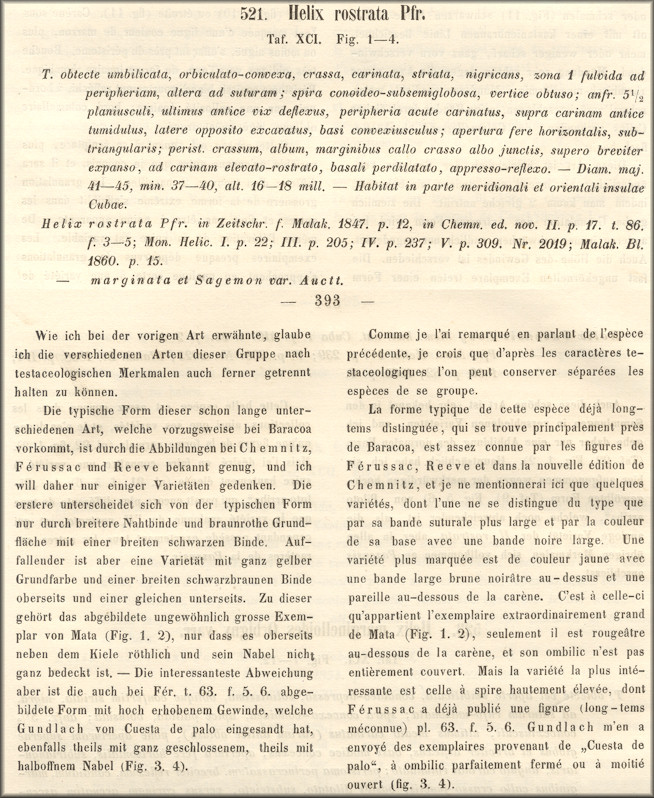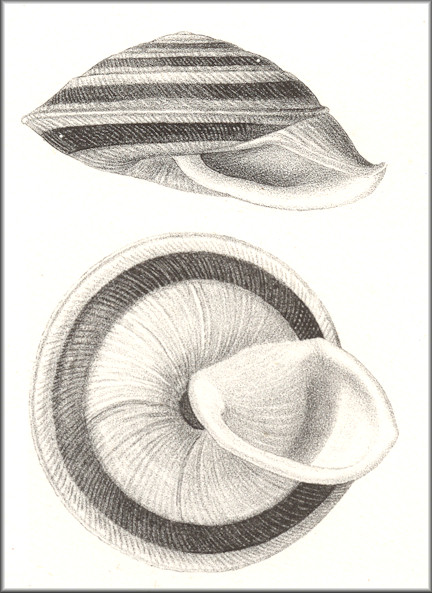|
In search of the identity of Caracolus rostrata (L. Pfeiffer, 1847) |
| Helix rostrata L. Pfeiffer (1847: 12) was described without a figure. Subsequently the author illustrated his species twice: in the Conchylien Cabinet and later in his Novitates Conchologicae. The description and figures below are taken from the latter work (L. Pfeiffer, 1868: 392-393; pl. 91, figs. 1-2): |
|
Johnson, R. I., 1969. Pfeiffer’s Novitates Conchologicae, Series I, Land Mollusca, 1854–1879, and Dunker’s Novitates Conchologicae, Series II, Marine Mollusca 1862–1882. A complete collation. Journal of the Society for the Bibliography of Natural History 5(3): 236–239. October. Pfeiffer, L., 1847 Diagnosen neuer Heliceen. Zeitschrift für Malakozoologie 4: 12-16. Jan. Pfeiffer, L., 1848-1865. Gedeckelte Lungenschnecken (Helicinacea und Cyclostomaceen) in Martini, F.H.W and H. Chemnitz [ed.], Systematisches Conchylien Cabinet. Band I, Abt. 19: 1-400, 50 pls. Pfeiffer L., 1867-1869. Novitates Conchologicae. Series Prima. Mollusca Extramarina Beschreibung und Abbildung neuer oder kritischer Land- und Süsswasser-Mollusken (Mit Einschluss der Auriculaceen) 3. T. Fischer, Cassel. Pp 301- 510 + pls. 73-108. [see collation below; much more complete collations can be found in Johnson, 1969; also Cowie et al., 1995 (vols. 1-4)]:
Pfeiffer L. [ed. in partim], 1854-79. Novitates Conchologicae.
Series Prima. Mollusca Extramarina Beschreibung und Abbildung neuer oder
kritischer Land- und Süsswasser-Mollusken (Mit Einschluss der
Auriculaceen). 5 volumes. T. Fischer, Cassel. |
|
What about Caracolus sagemon and C. bornii; solutions or a Sisyphean task? |
|
Aside from Helix marginella Gmelin, 1791 and H. rostrata
L. Pfeiffer, 1847, there are two other pre-1850 taxa that appear in
various discussions of the taxonomy of banded Caracolus. Beck (1837: 31) proposed Helix sagemon based, according to Pilsbry (1889: 123), on "the same figure Gmelin cites for his H. marginella!" [his exclamation point]. I can't find access to the Beck opus, but it should be closely checked to see which (if not both) of the Gmelin indications was cited. Below I discuss a potential solution for the clarification of this matter along with other aspects of the byzantine taxonomy and nomenclature of the banded Caracolus. Louis Pfeiffer (1848: 391) disinterred the name Helix bornii (lifted from Chemnitz, 1786: 80) and based this taxon on the on the same two figures as Gmelin used for his H. marginella. Pfeiffer's intention clearly was to reveal the priority of the Chemnitz name over that of Gmelin, whose H. marginella Pfeiffer placed in synonymy. Since this was the first validation of the Chemnitz name, which is unavailable for the purposes of taxonomic nomenclature (not consistently binominal; ICZN Opinion 189), without some clarification of the Gmelin typification, I see no other recourse but to consider H. bornii L. Pfeiffer, 1848 an objective junior synonym of H. marginella Gmelin, 1791. However, it is potentially relevant that Pfeiffer's concept of this taxon involved (1) "Puerto Rico," (2) a close affinity with (his concept of) H. sagemon Beck, 1837 (localized in the vicinity of Santiago, Cuba), (3) and "late umbilicatae" shared by the two (Pfeiffer, 1847: 22-23; 1848: 391). In the probable absence of actual type specimen(s), one solution to the ambiguity would be to restrict the type figure of H. marginella Gmelin. Option one might be the Chemnitz figure since the text clearly indicates the shell to be umbilicate. However, to the extent that the umbilicus is a salient taxonomic feature, this action might very well throw both H. sagemon and H. bornii into junior synonymy. Using the Born figure, near lack of an umbilicus notwithstanding, would conform to most subsequent authors' (e.g., Pilsbry,1889: 122) concept of the taxon, free up H. rostrata [?+ H. sagemon] for the umbilicate Cuban taxon and H. bornii for the Puerto Rican one. As I contemplate the trajectory of all these hypotheticals, I must admit to being influenced by a major deterrent to the energy expenditure needed to press on. Pilsbry (1889: 123) noted the following: "After studying a suite of several hundred specimens of banded Caracolus from numerous localities, I am disposed to unite all of the forms under the oldest [available] name, maraginella.[lapsus calami pro marginella]. I am convinced that there are no characters of the shells, either of contour, sculpture or color, which do not absolutely and by imperceptible degree shade from one form into another.... All Cuban Caracolus have already been united by Arango under the name H. sagemon Beck. I .... have given to the bibliography of the group an amount of time and labor all out of proportion to the apparent results." I must admit to having less material before me than what Pilsbry had marshalled, but what I have and what I see in the literature give me no good reason to dispute him. Accordingly, I am going to suspend any further efforts to clarify the taxonomy of the banded Caracolus, make wholesale application of the nominal taxon C. marginella (Gmelin, 1791), and characterize attributes such as shell profile, coloration, and umbilical diameter (including zero) in plain old English. Beck, H., 1837-1838. Index Molluscorum praesentis aevis Musei Principis Augustissimi Christiani Frederici. Copenhagen. [1837: 1-100; 1838: 101-124, 1-8 for collation see Kennard and Woodward, 1926: 364]. Kennard, A. S. and B. B. Woodward. 1926. Synonymy of the British non-marine Mollusca. British Museum, London. 447 pp. Pfeiffer, L., 1847-1848. Monographia heliceorum viventium. Sistens descriptiones systematicas et criticas omnium huius familiae generum et specierum hodie cognitarum. Volumen primum. F.A. Brockhaus, Lipsiae [Leipzig]. xxxii + 1-484. [7 or more fascicles issued] Pilsbry, H. A., 1889. Manual of Conchology (second series). 5. Helicidae, - Vol. III. Academy of Natural Sciences, Philadelphia. pp. 1-216 + 64 pls. March. |

